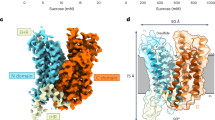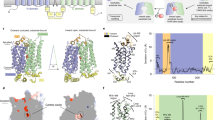Abstract
Sugarcane cell suspensions took up sugar from the medium at rates comparable to or greater than sugarcane tissue slices or plants in the field. This system offers an opportunity for the study of kinetic and energetic mechanisms of sugar transport in storage parenchyma-like cells in the absence of heterogeneity introduced by tissues. The following results were obtained: (a) The sugar uptake system was specific for hexoses; as previously proposed, sucrose was hydrolyzed by an extracellular invertase before the sugar moieties were taken up; no evidence for multiple sugar uptake systems was obtained. — (b) Uptake of the glucose-analog 3-O-methylglucose (3-OMG) reached a plateau value with an intracellular concentration higher than in the medium (approximately 15-fold). — (c) There was a balance of influx and efflux during steady state; the rate of exchange influx was lower than the rate of net influx; the Km value was higher (70 μM) than for net influx (24 μM); the exchange efflux is proposed to be mediated by the same transport system with a Km value of approximately 2.6 mM for internal 3-OMG; the rate of net efflux of hexoses was less than a third of the rate of exchange efflux. — (d) The uptake of hexoses proceeded as proton-symport with a stoichiometry of 0.87 H+ per sugar; during the onset of hexose transport there was a K+ exit of 0.94 K+ per sugar for charge compensation. (It was assumed that the “real” stoichiometries are 1 H+ and 1 K+ per sugar.) The Km values for sugar transport and sugar-induced proton uptake were identical. Sucrose induced proton uptake only in the presence of cell wall invertase. — (e) There was no net proton uptake with 3-OMG by cells which were preloaded with glucose though there was significant sugar uptake. It is assumed, therefore, that the exit of hexose occurs together with protons. — (f) The protonmotive potential of sugarcane cells corresponded to about 120 mV: pH-gradient 1.1 units, membrane potential of-60 mV (these values increased if vacuolar pH and membrane potential were also considered). It was abolished by uncouplers, and the magnitude of the components depended on the external pH value. We present evidence for the operation of a proton-coupled sugar transport system in cell suspensions that were derived from, and have characteristics of, storage parenchyma. The quantitative rates of sugar transport suggest that the role of this transport system is not limiting for sugar storage.
Similar content being viewed by others
Abbreviations
- 3-OMG:
-
3-O methylglucose
- DMO:
-
5,5-dimethyl-2, 4-oxazolidinedione
- TPP:
-
tetraphenylphosphonium chloride
- CCCP:
-
carbonyl cyanide, m-chlorophenylhydrozane
References
Bowen, J. (1972) Sugar transport in immature internodal tissue of sugar cane. I. Mechanism and kinetics of accumulation. Plant Physiol. 49, 82–86
Bowen, J.E., Hunter, J.E. (1972) Sugar transport in immature internodal tissue of sugar cane. II. Mechanism of sucrose transport. Plant Physiol. 49, 789–793
Butler, T.L., Wadell, W.J., Poole, D.T. (1967) Intracellular pH based on the distribution of weak electrolytes. Fed. Proc. 26, 1327–1330
Decker, M., Tanner, W. (1972) Respiratory increase and active hexose uptake of Chlorella vulgaris. Biochim. Biophys. Acta 266, 661–669
Delrot, S., Bonnemain, J.-L. (1979) Echanges H+-Rb+ et cotransport H+-glucide dans des tissus foliaires de Vicia faba L. C.R. Acad. Sci. Paris 288, 71–76
Flagg, J.L., Wilson, T.H. (1978) A novel type of coupling between proline and galactoside transport in Escherichia coli. Membr. Biochem. 1, 61–72
Gayler, K.R., Glasziou, K.T. (1972) Sugar accumulation in sugarcane. Carrier-mediated active transport of glucose. Plant Physiol. 49, 563–568
Giaquinta, R. (1980) Mechanism and control of phloem loading of sucrose. Ber. Dtsch. Bot. Ges. 93, 187–201
Glasziou, K.T. (1962) Accumulation and transformation of sugars in sugarcane stalks: Mechanism of inversion of sucrose in the inner space. Nature 193, 1100
Glasziou, K.T., Gayler, K.R. (1972) Storage of sugars in stalks of sugar cane. Bot. Rev. 38, 471–490
Hancock, J.G. (1970) Properties and formation of the squash high-affinity glucose transport system. Can. J. Bot. 48, 1515–1520
Heyser, W. (1980) Phloem loading in the maize leaf. Ber. Dtsch. Bot. Ges. 93, 221–228
Höfer, M. (1971) Transport of monosaccharides in Rhodotorula gracilis in the absence of metabolic energy. Arch. Mikrobiol. 80, 50–61
Humphreys, T.E. (1978) A model for sucrose transport in the maize scutellum. Phytochemistry 12, 1211–1219
Humphreys, T.E., Smith, R.C. (1980) Sucrose efflux from the maize scutellum. Ber. Dtsch. Bot. Ges. 93, 229–241
Komor, E. (1977) Sucrose uptake by cotyledons of Ricinus communis L.: characteristics, mechanism and regulation. Planta 137, 119–131
Komor, E., Tanner, W. (1976) The determination of the membrane potential of Chlorella vulgaris. Evidence for electrogenic sugar transport. Eur. J. Biochem. 70, 197–204
Komor, E., Haaß, D., Tanner, W. (1972) Unusual features of the active hexose uptake system of Chlorella vulgaris. Biochim. Biophys. Acta 266, 649–660
Komor, E., Haaß, D., Komor, B., Tanner, W. (1973) The active hexose uptake system of Chlorella vulgaris. Km-values for 6-deoxyglucose influx and efflux and their contribution to sugar accumulation. Eur. J. Biochem. 39, 193–200
Komor, E., Loos, E., Tanner, W. (1973) A confirmation of the proposed model for the hexose uptake system of Chlorella vulgaris. Anaerobic studies in the light and in the dark. J. Membr. Biol. 12, 89–99
Komor, E., Rotter, M., Tanner, W. (1977) A proton-cotransport system in higher plant: sucrose transport in Ricinus communis. Plant. Sci. Lett. 9, 153–162
Maretzki, A., Thom, M. (1970) Arginine and lysine transport in sugarcane cell suspension cultures. Biochemistry 9: 2731–2736
Maretzki, A., Thom, M. (1972a) Membrane transport of sugars in cell suspensions of sugarcane. I. Evidence of sites and specificity. Plant Physiol. 49, 172–182
Maretzki, A., Thom, M. (1972b) The existence of two membrane transport systems for glucose in suspensions of sugarcane cells. Biochem. Biophys. Res. Commun. 47, 44–50
Maretzki, A., Thom, M. (1980) Characteristics of glucose transport in Saccharum sp. cell suspensions. In: Plant membrane transport: current conceptual issues, pp. 565–566, Spanswick, R.M., Lucas, W.J., Dainty, J., eds. Elsevier North Holland Biochemical Press, Amsterdem
Marrè, E. (1979) Fusicoccin: a tool in plant physiology. Annu. Rev. Plant Physiol. 30, 273–288
Martin, E., Komor, E. (1980) Role of phloem in sucrose transport by Ricinus cotyledons. Planta 148, 367–373
Nickell, L.G. (1964) Tissue and cell cultures of sugarcane-another research tool. Hawaiian Pl. Rec. 57, 223–229
Nickell, L.G., Maretzki, A. (1969) Growth of suspension cultures of sugarcane cells in chemically defined media. Physiol. Plant. 22, 117–125
Oxender, D.L. (1972) Membrane transport. Annu. Rev. Biochem. 41, 778–814
Regen, D.M., Tarpley, H.L. (1974) Anomalous transport kinetics and the glucose carrier hypothesis. Biochim. Biophys. Acta 339, 218–233
Robbie, J.P., Wilson, T.H. (1969) Transmembrane effects of β-galactosides on thiomethyl-β-galactoside transport in Escherichia coli. Biochim. Biophys. Acta 173, 234–244
Sacher, J.A., Hatch, D., Glasziou, K.T. (1963) Sugar accumulation cycle in sugarcane. III. Physical and metabolic aspects of the cycle in immature storage tissues. Plant Physiol. 38, 348–354
Schneider, R.P., Wiley, W.R. (1971) Kinetic characteristics of the two glucose transport systems in Neurospora crassa. J. Bacteriol. 106, 479–486
Thom, M., Maretzki, A., Komor, E., and Sakai, E. (1981) Nutrient uptake and accumulation by sugarcane cell cultures in relation to the growth cycle. Plant Cell, Tissue and Organ Culture. (in press)
Tipton, C.L., Mondal, H.M., Benson, M.J. (1975) K+-stimulated adenosine triphosphatase of maize roots: Partial purification and inhibition by Helminthosporium maydis race T toxin. Physiol. Plant Pathol. 7, 277–286
Author information
Authors and Affiliations
Rights and permissions
About this article
Cite this article
Komor, E., Thom, M. & Maretzki, A. The mechanism of sugar uptake by sugarcane suspension cells. Planta 153, 181–192 (1981). https://doi.org/10.1007/BF00384100
Received:
Accepted:
Issue Date:
DOI: https://doi.org/10.1007/BF00384100




